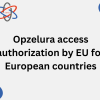
- Opzelura® (ruxolitinib) Cream is the first approved treatment in the European Union (EU) to address repigmentation in non-segmental vitiligo
- Phase 3 data supporting the approval show treatment with Opzelura resulted in improved facial and total body repigmentation, sustained and continued improvements with longer duration of treatment
WILMINGTON, Del.–(BUSINESS WIRE)–Apr. 20, 2023– Incyte (Nasdaq:INCY) today announced that the European Commission (EC) has granted a marketing authorization for Opzelura® (ruxolitinib) cream 15mg/g for the treatment of non-segmental vitiligo with facial involvement in adults and adolescents from 12 years of age. Opzelura is the first and only approved treatment in the European Union (EU) to offer support for repigmentation in eligible patients with non-segmental vitiligo, a chronic autoimmune disease characterized by depigmentation of skin and reduced quality of life.
The EC decision follows the positive opinion received from the European Medicines Agency’s Committee for Medicinal Products for Human Use (CHMP) earlier this year and is applicable to all 27 European Union Member States, Iceland, Norway and Liechtenstein.
“The approval of Opzelura by the European Commission represents a significant advancement for people living with non-segmental vitiligo with facial involvement who, until now, had no approved medical treatment to address repigmentation,” said Hervé Hoppenot, Chief Executive Officer, Incyte. “This approval wouldn’t have been possible without the support of the vitiligo patient and medical community, and the efforts of our research and development teams. We will now work across individual countries in Europe to bring this much awaited therapy to eligible patients seeking to treat their vitiligo.”
The EC decision is based on data from two pivotal Phase 3 clinical trials (TRuE-V1 [NCT04052425] and TRuE-V2 [NCT04057573]), evaluating the efficacy and safety of Opzelura versus vehicle (non-medicated cream) in more than 600 people with non-segmental vitiligo, age 12 and older. Results from the TRuE-V program showed that treatment with Opzelura resulted in significant improvements in facial and total body repigmentation versus vehicle as shown by the number of patients reaching the facial and total body Vitiligo Area Scoring Index (F-VASI-T-VASI) endpoints at Week 24 compared to vehicle and in an open-label extension at Week 521.
Results at Week 24, which were consistent across both studies, showed that 29.8% and 30.9% of patients treated with Opzelura achieved ≥75% improvement from baseline in the facial Vitiligo Area Scoring Index (F-VASI75), the primary endpoint, compared to 7.4% and 11.4% of patients treated with vehicle in TRuE-V1 and TRuE-V2, respectively. At Week 52, approximately one in two of Opzelura-treated patients achieved F-VASI751.
Additionally, at Week 24, more than 15% of patients treated with Opzelura achieved ≥90% improvement from baseline in F-VASI (F-VASI90), compared to approximately 2% of patients treated with vehicle. At Week 52, approximately one in three of Opzelura-treated patients achieved F-VASI90.
There were no serious treatment-related adverse events related to ruxolitinib cream and the most common adverse reaction was application site acne1.
Pivotal Phase 3 data supporting the European Commission decision were also published in The New England Journal of Medicine.
“The approval of Opzelura is welcome news for dermatologists and eligible patients in Europe who often face challenges managing vitiligo,” said Prof. Dr. Markus Böhm, Department of Dermatology, University of Münster Germany. “TRuE-V is the first large-scale clinical trials program in vitiligo and its results clearly demonstrate the clinically meaningful improvements in facial and total body repigmentation seen with Opzelura and its potential to further optimize patient care and outcomes.”
Vitiligo is a chronic autoimmune disease characterized by depigmentation of skin that results in patchy loss of skin color from the progressive destruction of pigment-producing cells known as melanocytes. Over-activity of the JAK signaling pathway is believed to drive inflammation involved in the pathogenesis and progression of vitiligo. In the European Union, EEA countries and UK diagnosed vitiligo prevalence is estimated to be ~1.5 million patients2,3, with approximately 8 in 10 patients suffering from non-segmental vitiligo4, and a subset of whom has facial involvement and seeking treatment. Vitiligo can occur at any age, although many patients with vitiligo will experience initial onset before the age of 305.
“Vitiligo is a chronic autoimmune disease that impacts many aspects of a person’s life,” said Jean-Marie Meurant, Vice-President of the Vitiligo International Patient Organizations Committee (VIPOC). “The arrival of new treatment options are important for our community as it gives people with vitiligo something they have long been hoping for: the choice to treat their disease.”
About Opzelura® (ruxolitinib) Cream 15mg/g
Opzelura, a novel cream formulation of Incyte’s selective JAK1/JAK2 inhibitor ruxolitinib, is the first and only topical JAK inhibitor approved for use in the European Union (EU), indicated for the treatment of non-segmental vitiligo with facial involvement in adults and adolescents from 12 years of age.
In patients with non-segmental vitiligo with facial involvement, Opzelura is approved for topical use twice daily to the depigmented skin areas up to a maximum of 10% body surface area. Satisfactory repigmentation may require treatment with Opzelura for more than 24 weeks.
Opzelura is approved in the U.S. for the topical treatment of non-segmental vitiligo in patients 12 years of age and older and for the topical short-term and non-continuous chronic treatment of mild to moderate atopic dermatitis (AD) in non-immunocompromised patients 12 years of age and older whose disease is not adequately controlled with topical prescription therapies, or when those therapies are not advisable.
Incyte has worldwide rights for the development and commercialization of Opzelura. In April 2022, Incyte entered into a strategic alliance agreement with Maruho Co., Ltd. for the development, manufacturing, and exclusive commercialization of ruxolitinib cream for treatment of autoimmune and inflammatory dermatology indications in Japan.
Opzelura is a trademark of Incyte.
About Incyte Dermatology
Incyte’s science-first approach and expertise in immunology has formed the foundation of the company. Today, we are building on this legacy as we discover and develop innovative dermatology treatments to bring solutions to patients in need.
Our research and development efforts in dermatology are initially focused on leveraging our knowledge of the JAK-STAT pathway. We are exploring the potential of JAK inhibition for a number of immune-mediated dermatologic conditions with a high unmet medical need, including atopic dermatitis, vitiligo, lichen planus, lichen sclerosus and prurigo nodularis.
About Incyte
Incyte is a Wilmington, Delaware-based, global biopharmaceutical company focused on finding solutions for serious unmet medical needs through the discovery, development and commercialization of proprietary therapeutics.
____________________
1 Opzelura® (ruxolitinib) cream 15mg/g. Summary of Product Characteristics (SmPC). Incyte; April 2023.
2 Mohr N, et al. Epidemiology of Vitiligo – A Dual Population-Based Approach. Clinical Epidemiology. 2021 May 26; 13:373-382.
3 Bibeau K, et al. Vitiligo prevalence and quality of life among adults in Europe, Japan and the USA. Journal of the European Academy of Dermatology and Venerology. 2022; V36(10), P 1831-1844.
4 Gandhi K, et al. Prevalence of Vitiligo Among Adults in the United States. JAMA Dermatol. 2022 Jan 1;158(1):43-50.
5 Frisoli M, et al. Vitiligo: mechanisms of pathogenesis and treatment. Annual. Review of Immunology. 2020; 38(1):621-648.




